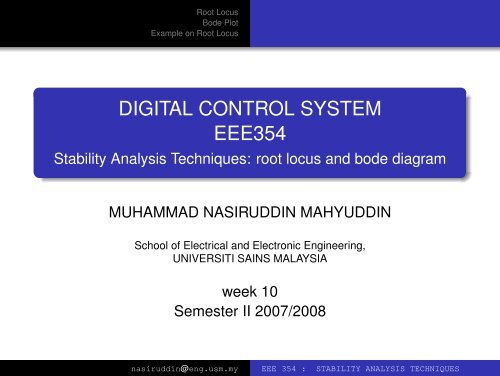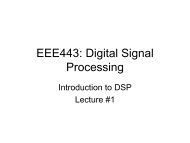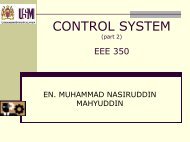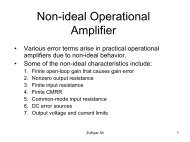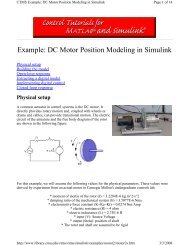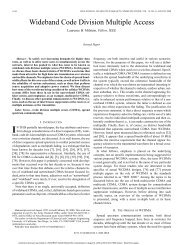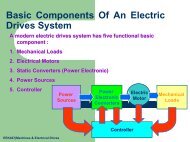Lecture notes - School Of Electrical & Electronic Engineering - USM
Lecture notes - School Of Electrical & Electronic Engineering - USM
Lecture notes - School Of Electrical & Electronic Engineering - USM
Create successful ePaper yourself
Turn your PDF publications into a flip-book with our unique Google optimized e-Paper software.
Root Locus<br />
Bode Plot<br />
Example on Root Locus<br />
DIGITAL CONTROL SYSTEM<br />
EEE354<br />
Stability Analysis Techniques: root locus and bode diagram<br />
MUHAMMAD NASIRUDDIN MAHYUDDIN<br />
<strong>School</strong> of <strong>Electrical</strong> and <strong>Electronic</strong> <strong>Engineering</strong>,<br />
UNIVERSITI SAINS MALAYSIA<br />
week 10<br />
Semester II 2007/2008<br />
nasiruddin@eng.usm.my EEE 354 : STABILITY ANALYSIS TECHNIQUES
Outline<br />
Root Locus<br />
Bode Plot<br />
Example on Root Locus<br />
week 10: 18/02/2008 - 23/02/2008<br />
1 Root Locus<br />
overview<br />
general rules of Root Loci sketching<br />
2 Bode Plot<br />
Advantages of Bode Plot<br />
Sketching technique revisited<br />
Performance Specification<br />
example on frequency response analysis: bode plot<br />
3 Example on Root Locus<br />
nasiruddin@eng.usm.my EEE 354 : STABILITY ANALYSIS TECHNIQUES
Root Locus<br />
Bode Plot<br />
Example on Root Locus<br />
stability technique using root locus<br />
overview<br />
general rules of Root Loci sketching<br />
Generally, the CE for a digital system can be written as<br />
where,<br />
1 + F(z) = 0<br />
F(z) = G(z)H(z) or F(z) = GH(z)<br />
F(z) is the open-loop pulse transfer function of the discrete-time<br />
or digital system. Since F(z) is a complex quantity, it can be<br />
split into two equations: angles and magnitude.<br />
nasiruddin@eng.usm.my EEE 354 : STABILITY ANALYSIS TECHNIQUES
Root Locus<br />
Bode Plot<br />
Example on Root Locus<br />
stability technique using root locus<br />
overview<br />
general rules of Root Loci sketching<br />
a) Angle Criterion:<br />
b) Magnitude Criterion:<br />
∠F(z) = ±180 ◦ (2k + 1), k = 0, 1, 2, ... (1)<br />
|F(z)| = 1 (2)<br />
The values of z that satisfy both the angle and the mangitude<br />
criterions are the roots of characteristic equations.<br />
nasiruddin@eng.usm.my EEE 354 : STABILITY ANALYSIS TECHNIQUES
Root Locus<br />
Bode Plot<br />
Example on Root Locus<br />
Rules of sketching ROOT LOCI<br />
overview<br />
general rules of Root Loci sketching<br />
1 Obtain the characteristic equation or CE: 1 + F(z)<br />
2 Find the starting point(poles) : K = 0, (and the number of<br />
poles, n)<br />
3 Find the ending point(zeros) : K = ∞, (and the number of<br />
zeros, m)<br />
4 The number of end points at infinity : n − m<br />
5 Find the root loci on the real axis: Use the right test point<br />
method...<br />
nasiruddin@eng.usm.my EEE 354 : STABILITY ANALYSIS TECHNIQUES
Root Locus<br />
Bode Plot<br />
Example on Root Locus<br />
Rules of sketching ROOT LOCI<br />
overview<br />
general rules of Root Loci sketching<br />
1 Determine the asymptotes:<br />
Angle of asymptotes:<br />
θ q =<br />
(2k + 1)π<br />
, k = 0, 1, 2, . . . , |n − m| − 1 (3)<br />
n − m<br />
Intersection of asymptotes with the real axis:<br />
σ 1 =<br />
∑ ∑ real parts of poles of F(z) − real parts of zeros of F(z)<br />
. (<br />
n − m<br />
nasiruddin@eng.usm.my EEE 354 : STABILITY ANALYSIS TECHNIQUES
Root Locus<br />
Bode Plot<br />
Example on Root Locus<br />
Rules of sketching ROOT LOCI<br />
overview<br />
general rules of Root Loci sketching<br />
1 Find the break-away and break-in points on the real axis, if<br />
any:<br />
1 + F(z) = 1 + KF 1 (z) = 0<br />
K = − 1<br />
F(z)<br />
(5)<br />
The break-away and break-in point can be determined<br />
from the roots of<br />
dK<br />
dz = − d 1<br />
dz F 1 (z) = 0 (6)<br />
nasiruddin@eng.usm.my EEE 354 : STABILITY ANALYSIS TECHNIQUES
Find the point(s) where the root loci cross the imaginary<br />
axis.<br />
It can be found by setting z = jω in CE. Then, equate both<br />
the real part and the imaginary part to zero, and solve for ω<br />
and K. ω is the point where the root loci cross the<br />
imaginary axis and K the corresponding gain at that<br />
cross-over nasiruddin@eng.usm.my point.<br />
EEE 354 : STABILITY ANALYSIS TECHNIQUES<br />
Root Locus<br />
Bode Plot<br />
Example on Root Locus<br />
Rules of sketching ROOT LOCI<br />
overview<br />
general rules of Root Loci sketching<br />
Determine the angle of departure (or the angle of arrival)<br />
of the root locus from the complex poles (or at the complex<br />
zeros):<br />
Angle of arrival:<br />
(you may use the angle of criterion to derive this equation)<br />
φ = 180 ◦ [ ∑<br />
∠(from all poles to φ) −<br />
∑<br />
∠(from all zeros to φ)<br />
]<br />
(7
Root Locus<br />
Bode Plot<br />
Example on Root Locus<br />
Rules of sketching ROOT LOCI<br />
overview<br />
general rules of Root Loci sketching<br />
The intersection of the root loci with the unit circle |z| = 1<br />
can be found by using the extended R-H or Jury’s stability<br />
test.<br />
The magnitude criterion enables us to determine the value<br />
of the gain K at any specific root location on the locus. The<br />
gain K can be found as follows:<br />
K =<br />
(z + p 1 )(z + p 2 ) . . . (z + p n )<br />
∣ (z + z 1 )(z + z 2 ) . . . (z + z m ) ∣ (8)<br />
Given the value of the gain, the closed loop pole for that<br />
gain can also be found by using the same formula.<br />
nasiruddin@eng.usm.my EEE 354 : STABILITY ANALYSIS TECHNIQUES
exercise<br />
Root Locus<br />
Bode Plot<br />
Example on Root Locus<br />
overview<br />
general rules of Root Loci sketching<br />
do exercise 7-14 in Philip Nagle book<br />
nasiruddin@eng.usm.my EEE 354 : STABILITY ANALYSIS TECHNIQUES
example<br />
Root Locus<br />
Bode Plot<br />
Example on Root Locus<br />
overview<br />
general rules of Root Loci sketching<br />
do exercise 4-7 in Ogata Book.<br />
Draw the root locus diagrams in the z-plane for the system for<br />
the following three sampling periods: T=1 sec; T= 2 sec and T<br />
= 4 sec.<br />
nasiruddin@eng.usm.my EEE 354 : STABILITY ANALYSIS TECHNIQUES
Root Locus<br />
Bode Plot<br />
Example on Root Locus<br />
Advantages of Bode Plot<br />
Advantages of Bode Plot<br />
Sketching technique revisited<br />
Performance Specification<br />
example on frequency response analysis: bode plot<br />
In the Bode diagram, the low frequency asymptote of the<br />
magnitude curve is indicative of one of the static error constants<br />
K p , K v , K a .<br />
Specifications of the transient response can be translated into<br />
those of frequency response in terms of the phase margin, gain<br />
margin, bandwidth, so forth. These can be easily handled in the<br />
bode diagram.<br />
The design of digital compensator to satisfy specifications can<br />
be carried out in the Bode diagram in a simple and<br />
straightforward manner<br />
nasiruddin@eng.usm.my EEE 354 : STABILITY ANALYSIS TECHNIQUES
Bode Plot<br />
Root Locus<br />
Bode Plot<br />
Example on Root Locus<br />
Advantages of Bode Plot<br />
Sketching technique revisited<br />
Performance Specification<br />
example on frequency response analysis: bode plot<br />
Before using the bode plot, the transfer function G(z) must first<br />
be converted into G(w ′ ) in w ′ domain by using the following<br />
bilinear transformation of equation 9<br />
z = 1 + T 2 w′<br />
1 − T 2 w′ =<br />
2<br />
T + w′<br />
2<br />
T − w′ (9)<br />
Since the Bode plot is a frequency domain analysis technique,<br />
G(jv ′ ) is obtained after the transform transfer function G(w ′ ) in<br />
w ′ -domain has beend determined by replacing w ′ with jv ′ .<br />
nasiruddin@eng.usm.my EEE 354 : STABILITY ANALYSIS TECHNIQUES
Bode Plot<br />
Root Locus<br />
Bode Plot<br />
Example on Root Locus<br />
Advantages of Bode Plot<br />
Sketching technique revisited<br />
Performance Specification<br />
example on frequency response analysis: bode plot<br />
The bode plot consists of two separate plots:<br />
a. The magnitude plots<br />
b. The phase plot<br />
Now, instead of using ω as an expression for frequency, we will<br />
use v ′ . This is called fictitious frequency.<br />
The magnitude |G(jv ′ )| is usually expressed in decibels (dB) i.e.<br />
20log 10 |G(jv ′ )|. The sketching techniques are the same as what<br />
you have learnt in EEE 350 whereby we plot each of the factors<br />
contribution in the bode plot and later, add all of these factors to<br />
form the complete plot of any given digital system transfer<br />
function. Yes, we still use asymptotic approximation in<br />
bode plot skteching.<br />
nasiruddin@eng.usm.my EEE 354 : STABILITY ANALYSIS TECHNIQUES
Root Locus<br />
Bode Plot<br />
Example on Root Locus<br />
Advantages of Bode Plot<br />
Sketching technique revisited<br />
Performance Specification<br />
example on frequency response analysis: bode plot<br />
The Magnitude and Phase plots for Factors in Bode<br />
plot<br />
Factor (jv ′ ) ±1<br />
nasiruddin@eng.usm.my EEE 354 : STABILITY ANALYSIS TECHNIQUES
Root Locus<br />
Bode Plot<br />
Example on Root Locus<br />
Advantages of Bode Plot<br />
Sketching technique revisited<br />
Performance Specification<br />
example on frequency response analysis: bode plot<br />
The Magnitude and Phase plots for Factors in Bode<br />
plot<br />
Factor (1 ± Ajv ′ )<br />
nasiruddin@eng.usm.my EEE 354 : STABILITY ANALYSIS TECHNIQUES
Root Locus<br />
Bode Plot<br />
Example on Root Locus<br />
Advantages of Bode Plot<br />
Sketching technique revisited<br />
Performance Specification<br />
example on frequency response analysis: bode plot<br />
The Magnitude and Phase plots for Factors in Bode<br />
plot<br />
Factor (1 ± Ajv ′ ) −1<br />
nasiruddin@eng.usm.my EEE 354 : STABILITY ANALYSIS TECHNIQUES
Root Locus<br />
Bode Plot<br />
Example on Root Locus<br />
Advantages of Bode Plot<br />
Sketching technique revisited<br />
Performance Specification<br />
example on frequency response analysis: bode plot<br />
The Magnitude and Phase plots for Factors in Bode<br />
plot<br />
Factor (B + Ajv ′ + (jv ′ ) 2 ) ±1<br />
nasiruddin@eng.usm.my EEE 354 : STABILITY ANALYSIS TECHNIQUES
Bode plot<br />
Root Locus<br />
Bode Plot<br />
Example on Root Locus<br />
Advantages of Bode Plot<br />
Sketching technique revisited<br />
Performance Specification<br />
example on frequency response analysis: bode plot<br />
The overall magnitude versus frequency plot for the system can be<br />
obtained by graphically adding all the plots of the various factors<br />
present in the transfer function.<br />
This does applied for digital systems as mush as it does on<br />
continuous systems.<br />
nasiruddin@eng.usm.my EEE 354 : STABILITY ANALYSIS TECHNIQUES
Root Locus<br />
Bode Plot<br />
Example on Root Locus<br />
Performance Specification<br />
Advantages of Bode Plot<br />
Sketching technique revisited<br />
Performance Specification<br />
example on frequency response analysis: bode plot<br />
Relative stability of closed-loop systems can be judged based<br />
on two performance specification in the frequency domain:<br />
Gain Margin<br />
Phase Margin<br />
nasiruddin@eng.usm.my EEE 354 : STABILITY ANALYSIS TECHNIQUES
Root Locus<br />
Bode Plot<br />
Example on Root Locus<br />
Performance Specification<br />
Advantages of Bode Plot<br />
Sketching technique revisited<br />
Performance Specification<br />
example on frequency response analysis: bode plot<br />
Gain Margin:<br />
The gain margin is the number of dB that |G(jv ′ | is<br />
below 0 dB at the phase crossover frequency (phase<br />
angle φ of G(jv ′ ) = 180 ◦ . It can also be defined as the<br />
amount of the system gain that can be increase before<br />
the closed loop system becomes unstable.<br />
Phase Margin: The phase margin is the number of degrees the<br />
phase of |G(jv ′ | is above −180 ◦ at the gain crossover<br />
frequency (|G(jv ′ | = 1. It can also be defined as the<br />
angle where the phase can be increased before the<br />
closed loop system becomes unstable<br />
nasiruddin@eng.usm.my EEE 354 : STABILITY ANALYSIS TECHNIQUES
Root Locus<br />
Bode Plot<br />
Example on Root Locus<br />
Gain and Phase Margin<br />
Advantages of Bode Plot<br />
Sketching technique revisited<br />
Performance Specification<br />
example on frequency response analysis: bode plot<br />
The system is unstable if either the gain margin or the phase margin<br />
or both have a negative value as shown in Figure 1<br />
Figure 1: Gain and Phase Margin in bode diagram<br />
nasiruddin@eng.usm.my EEE 354 : STABILITY ANALYSIS TECHNIQUES
Root Locus<br />
Bode Plot<br />
Example on Root Locus<br />
Gain and Phase margin<br />
Advantages of Bode Plot<br />
Sketching technique revisited<br />
Performance Specification<br />
example on frequency response analysis: bode plot<br />
Stable and unstable system in Bode diagram are shown in<br />
Figure 2<br />
Figure 2: Gain and Phase Margin in bode diagram<br />
nasiruddin@eng.usm.my EEE 354 : STABILITY ANALYSIS TECHNIQUES
Example<br />
Root Locus<br />
Bode Plot<br />
Example on Root Locus<br />
Advantages of Bode Plot<br />
Sketching technique revisited<br />
Performance Specification<br />
example on frequency response analysis: bode plot<br />
Consider a system with the following transfer function as shown in Figure 3:<br />
Figure 3: System plant<br />
Assuming the input is a unit step function, calculate the following:<br />
1 The range of stability for gain K using Routh Hurwitz method.<br />
2 Verify the answer in part (a) by plotting bode plot for the system.<br />
3 Find the gain and phase margin for th system from the bode plot drawn.<br />
nasiruddin@eng.usm.my EEE 354 : STABILITY ANALYSIS TECHNIQUES
Root Locus<br />
Bode Plot<br />
Example on Root Locus<br />
Solution to the example<br />
Advantages of Bode Plot<br />
Sketching technique revisited<br />
Performance Specification<br />
example on frequency response analysis: bode plot<br />
G(z) can be calculated as follows:<br />
G(z)<br />
= ( z−1<br />
z<br />
)<br />
Z<br />
[<br />
1<br />
s 2 (s+1)<br />
]<br />
T=1<br />
= z−1<br />
z<br />
[ ]<br />
z[(1−1+e −1 )z+(1−e −1 −e −1 )]<br />
(z−1) 2 (z−e −1 )<br />
(10)<br />
= 0.368z+0.264<br />
z 2 −1.368z+0.368<br />
nasiruddin@eng.usm.my EEE 354 : STABILITY ANALYSIS TECHNIQUES
Root Locus<br />
Bode Plot<br />
Example on Root Locus<br />
cont. solution to example<br />
Advantages of Bode Plot<br />
Sketching technique revisited<br />
Performance Specification<br />
example on frequency response analysis: bode plot<br />
With the sampling time given as T = 1 sec, the characteristic<br />
equation can be written as,<br />
1 + KG(w) = 1 + KG(z)| z=(1+0.5w)/(1−0.5w)<br />
= 1 +<br />
K[0.368[ 1+0.5w +0.264]]<br />
1−0.5w<br />
[ 1−0.5w] 1+0.5w 2 −1.368[ 1−0.5w]+0.368<br />
1+0.5w<br />
(11)<br />
nasiruddin@eng.usm.my EEE 354 : STABILITY ANALYSIS TECHNIQUES
Root Locus<br />
Bode Plot<br />
Example on Root Locus<br />
cont. solution to example<br />
Advantages of Bode Plot<br />
Sketching technique revisited<br />
Performance Specification<br />
example on frequency response analysis: bode plot<br />
1 + KG(w) = 1 + −0.0381K(w−2)(w+12.14)<br />
w(w+0.924)<br />
(12)<br />
= (1−0.0381K)w2 +(0.924−0.386K)w+0.924K<br />
w(w+0.924)<br />
The CE can be expressed as<br />
(1 − 0.0381K)w 2 + (0.924 − 0.386K)w + 0.924K = 0<br />
nasiruddin@eng.usm.my EEE 354 : STABILITY ANALYSIS TECHNIQUES
Root Locus<br />
Bode Plot<br />
Example on Root Locus<br />
cont. solution to example<br />
Advantages of Bode Plot<br />
Sketching technique revisited<br />
Performance Specification<br />
example on frequency response analysis: bode plot<br />
The Routh Hurwitz can be then formed as<br />
w 2 1 − 0.0381K 0.924K⇒K < 26.2<br />
w 1 0.924 − 0.386K ⇒K < 2.39<br />
w 0 0.924K ⇒K > 0<br />
(13)<br />
Hence the system is stable for 0
Root Locus<br />
Bode Plot<br />
Example on Root Locus<br />
cont. solution to example<br />
Advantages of Bode Plot<br />
Sketching technique revisited<br />
Performance Specification<br />
example on frequency response analysis: bode plot<br />
It is to remind that K = 2.39 is the critical gain or the gain which<br />
cause the system to be marginally stable.<br />
In a manner similar to that employed in continuous-time<br />
systems, the frequency of oscillation at K = 2.39 can be found<br />
from the w 2 row of the array. We may obtain the auxillary<br />
equation as such,<br />
(1 − 0.0381)w 2 + 0.924K| K=2.39 = 0.9089w 2 + 2.181 = 0<br />
or<br />
√<br />
2.181<br />
w = ±j<br />
0.9089 = ±j1.549<br />
nasiruddin@eng.usm.my EEE 354 : STABILITY ANALYSIS TECHNIQUES
Root Locus<br />
Bode Plot<br />
Example on Root Locus<br />
cont. Solution to example<br />
Advantages of Bode Plot<br />
Sketching technique revisited<br />
Performance Specification<br />
example on frequency response analysis: bode plot<br />
Then, ω w = 1.549 and from the relation between fictitious<br />
frequency and real frequency,<br />
[ ]<br />
ω w = 2 ωT<br />
T<br />
tan<br />
2 = 2 1 arctan (1.549)(1)<br />
2<br />
= 1.32rad/s<br />
It is found that 1.32 rad/s is the real frequency at which the<br />
system will oscillate with K=2.39.<br />
You may try different values of sampling time and reanalyze the<br />
system. You would see that the dependency of the system<br />
stability on the sampling period. The degradation of stability<br />
with increasing T, is due to the delay introduced by the sampler<br />
and data hold.<br />
nasiruddin@eng.usm.my EEE 354 : STABILITY ANALYSIS TECHNIQUES
Root Locus<br />
Bode Plot<br />
Example on Root Locus<br />
cont. solution to example<br />
Advantages of Bode Plot<br />
Sketching technique revisited<br />
Performance Specification<br />
example on frequency response analysis: bode plot<br />
Bode Diagram: a frequency response method to analyze<br />
system stability<br />
From equation 12, we would substitute G(w)| jωw and yield,<br />
G(jω w )<br />
= −0.0381(jωw−2)(jωw+12.14<br />
jω w(jω w+0.924)<br />
=<br />
−(j<br />
ωw<br />
2<br />
(14)<br />
jωw<br />
−1)( +1)<br />
12.14<br />
ω w( jωw +1) 0.924<br />
nasiruddin@eng.usm.my EEE 354 : STABILITY ANALYSIS TECHNIQUES
Bode plot drawn<br />
Root Locus<br />
Bode Plot<br />
Example on Root Locus<br />
Advantages of Bode Plot<br />
Sketching technique revisited<br />
Performance Specification<br />
example on frequency response analysis: bode plot<br />
By inspection, we note that the break frequencies are ω w = 2<br />
and ω w = 12.14 and the denominator break frequencies are ω w<br />
= 0 and ω w = 0.924. Using what you have learnt in the previous<br />
subject Sistem Kawalan, use asymptotic approximation to draw<br />
your bode plot. Note the gain and phase margin. The final bode<br />
plot will look something like in Figure 4<br />
nasiruddin@eng.usm.my EEE 354 : STABILITY ANALYSIS TECHNIQUES
Bode plot drawn<br />
Root Locus<br />
Bode Plot<br />
Example on Root Locus<br />
Advantages of Bode Plot<br />
Sketching technique revisited<br />
Performance Specification<br />
example on frequency response analysis: bode plot<br />
Figure 4: The bode plot of the system<br />
nasiruddin@eng.usm.my EEE 354 : STABILITY ANALYSIS TECHNIQUES
Root Locus<br />
Bode Plot<br />
Example on Root Locus<br />
Example on Root Locus<br />
You may study the example on root locus for digital system from<br />
the book on the next slides<br />
nasiruddin@eng.usm.my EEE 354 : STABILITY ANALYSIS TECHNIQUES
Example on Root Locus
Example 2 on Root Locus


